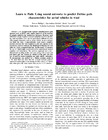Learn to Path: Using neural networks to predict Dubins path characteristics for aerial vehicles in wind
Abstract
For asymptotically optimal sampling-based path planners such as RRT*, path quality improves as the number of samples added to the motion tree increases. However, each additional sample requires a nearest-neighbor search. Calculating state transition costs can be particularly difficult in cases with complex dynamics such as aerial vehicles in non-isotropic cost fields like wind. Computationally costly nearest neighbor searches increase the time required to add new samples to the search tree, thereby reducing the likelihood of finding low-cost paths in a given computational time. In this paper, we propose the use of a lightweight neural network to approximate nearest neighbor cost calculations. The network approach uses a low-dimensional encoding of the cost space along with a start and goal query pair and returns an estimate of the path cost that can be used for nearest neighbor and path validity estimation. We demonstrate our method for a Dubins airplane model in a 3D wind field and show that the network method achieves equivalent path lengths as an existing iterative solver 32% faster and, when given the same search time, up to 10.8% shorter. Show more
Permanent link
https://doi.org/10.3929/ethz-b-000515766Publication status
publishedExternal links
Book title
2021 IEEE International Conference on Robotics and Automation (ICRA)Pages / Article No.
Publisher
IEEEEvent
Organisational unit
03737 - Siegwart, Roland Y. / Siegwart, Roland Y.
Notes
Conference lecture held on June 1, 2021More
Show all metadata
ETH Bibliography
yes
Altmetrics

